A conductor which ensures the connection of an electrolyte solution with the external electric circuit.
Calomel electrode
Combination electrode
Glass electrode
Electrogravimetric electrodes
Indicator electrode
Measuring electrode
Normal hydrogen electrode
Platinium electrode
Reference electrode
Silver electrode
Standard hydrogen electrode
Specific electrode
This consists a platinum wire dipping into mercury which is itself in contact with calomel (a salt with the formula Hg2Cl2, practically insoluble in mercury) and with a saturated aqueous solution of potassium chloride.
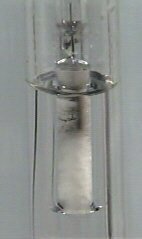
This electrode, denoted as Hg2Cl2 / Hg, is used as a secondary reference electrode .
When the solution of KCl is saturated, its potential at 25°C is 0.2444 V compared to the standard hydrogen electrode.
Combination of a reference electrode and an indicator electrode into a single probe. The Glass electrode are commonly available as combination electrode.
An electrode whose potential is proportional to the pH of the solution into which it is dipped.
It is made up of a glass ball (diameter less than 1 cm and thickness about a hundredth of mm) filled with a buffer solution of known pH (generally pH = 7) into which an internal electrode reference (generally AgCl / Ag in saturated KCl) is placed.
Commonly, the glass electrode is associated with a reference electrode and thus constitute a so-called "Combination electrode".
Cylindrical coaxial gauze electrodes made of platinum.

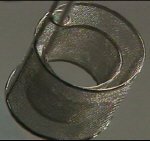
Indicator
electrode
/ measuring electrode
An electrode which, when placed in a solution, measures the activity or concentration of a given ion.
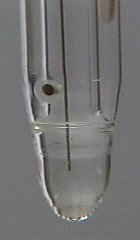
It can be used in conjunction with a reference electrode for potentiometric titrations.
Normal
hydrogen
electrode or
standard hydrogen
electrode
This is made up of a platinum foil immersed in a solution with a hydrogen ion activity of unity in contact with hydrogen gas at a standard pressure (p° = 1 bar).
This is the most inert electrode.
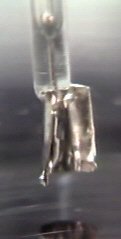
It is used together with a reference electrode for oxidation/reduction potentiometric titrations.
An electrode which has a constant and perfectly reproducible potential whatever the medium into which it is placed.
The standard reference electrode is the hydrogen electrode, which is based on the H3O+ / H2 couple.
As the hydrogen electrode is difficult to handle reproducibly, other reference electrodes are used. Most commonly these employ the calomel/mercury, mercurous sulphate/mercury, silver chloride/silver couples.
Such electrodes are used together with an indicating or measuring electrode, for potentiometric titrations.
This consists of a silver wire in contact with a saturated solution of silver chloride, AgCl.
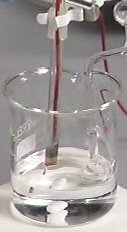
This electrode, denoted as AgCl / Ag, is often used as a secondary reference electrode, e.g. for potentiometric titrations.
A selective electrode is an electrode which, in the presence of a reference electrode, detects and measures the concentrations of a particular ion.
In such measurements a preliminary calibration is generally required .